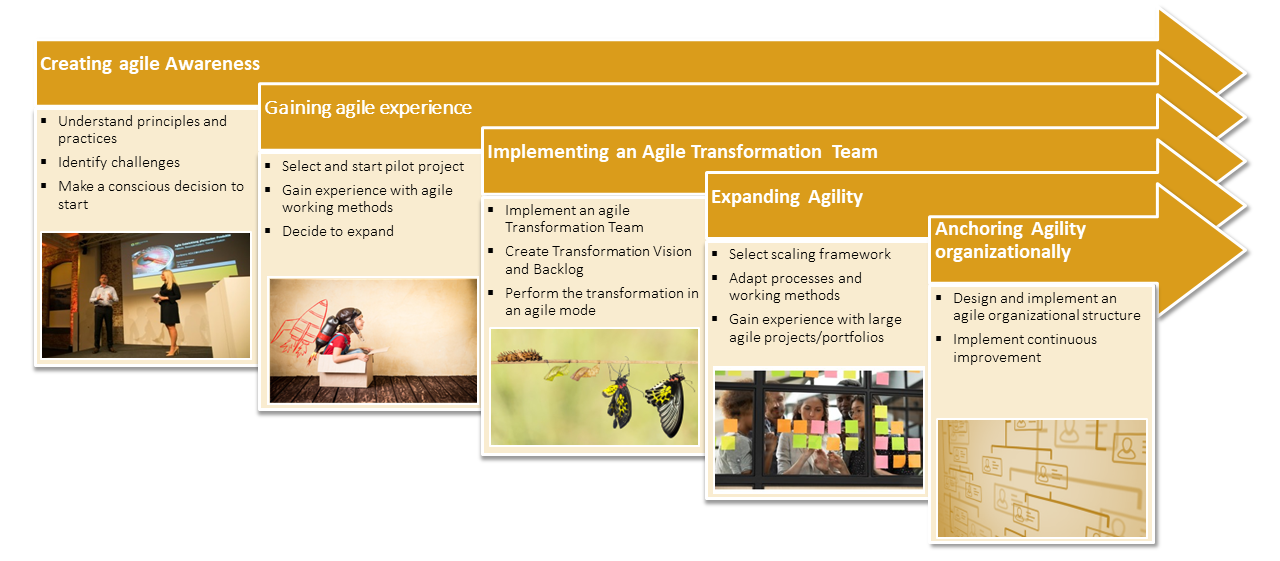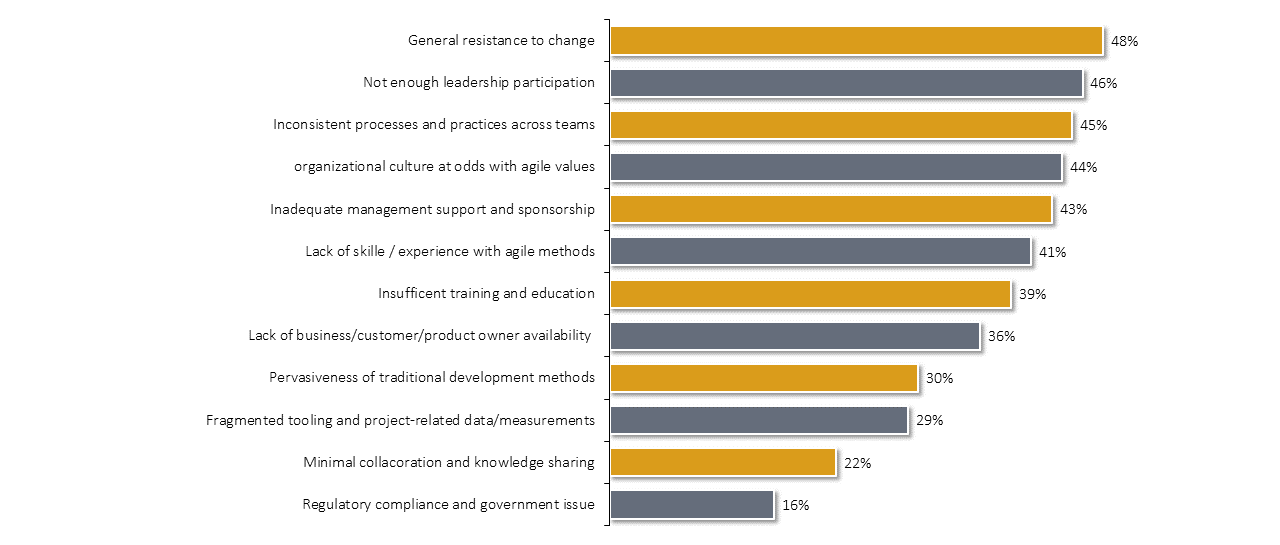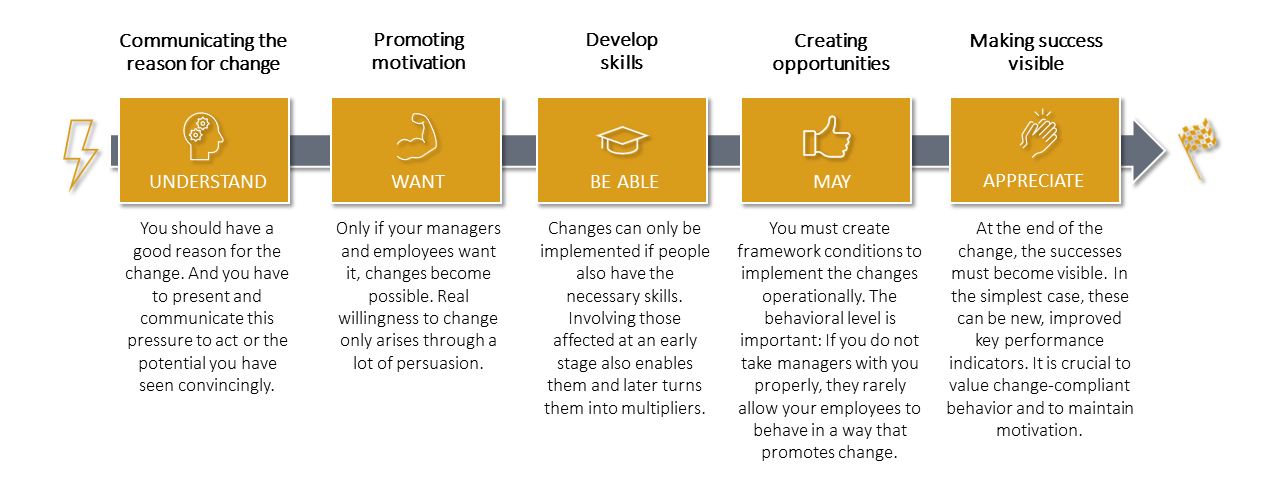Overview agile transformation
Agility has also become established extremely quickly in the development of mechatronic products. In an environment characterised by rapid changes, increasing uncertainty and high complexity, agile working methods are superior to classic management methods. We accompany you on the way from a classic to an agile organisation and ensure, with suitable change management, that agility is really embraced in your company.

The path to an agile company
The first approaches to agile procedures date back to the 1980s – in hardware development. Only later were they transferred to software development. Today, the agile development of physical products is common practice in the manufacturing industry. Agile working methods are a response to the increasing speed of change and the associated uncertainty, especially with regard to customer requirements and technological developments. Agile industrial companies respond to these typical factors of the VUCA world (Volatile, Uncertain, Complex, Ambiguous) with
- agile leadership,
- empirical process control and
- adaptive planning.
In agile procedures, much more room is given to independent action. The development team regularly presents interim results and discusses them with relevant stakeholders. The results of this feedback process flow directly into the development work. This makes it possible to better understand customer requirements and minimise risks at an early stage.
This iterative, short-cycle approach has numerous advantages for companies in the manufacturing industry:
- Meeting customer needs in a volatile world through short-cycle, regular feedback from customers and stakeholders.
- High effectiveness and increased value through consistent prioritisation.
- Increased efficiency and lower project costs through focus and continuous improvement.
- Shorter time-to-market and deadline reliability through team commitment and quick decisions.
- High transparency through defined events, open information and greater ownership.
- Higher level of employee satisfaction through more autonomy and trust, as well as fewer controlling measures.
However, it is of little use to introduce agile methods such as Scrum or Kanban without changes in leadership behaviour, framework conditions and corporate culture and hope that product development will benefit from the effects described here. This is because agility is more than a modern project management method that simply needs to be adapted. The path to an agile organisation is a complex change initiative that affects hierarchies and processes, as well as the entire culture of a company. This task can only succeed with the help of a structured approach: With an agile transformation. Our consultants have been supporting clients from traditional industries for years in driving agility forward step by step in their organisation. Five stages are crucial here, which we accompany with detailed change management. At which stage of the transformation are you?
Step 1: Create agile awareness
Companies must first create the basis for the use of agile methods. On the one hand, this concerns their rules and practices. On the other hand, managers must internalise and promote the principles and values that underlie agility. This is the prerequisite for benefiting from the advantages of agile development in the long-term.
People understand how agile methods work relatively quickly. We ourselves offer customers from traditional industries a two-day basic training course, for example, which focuses on the potential, values, success factors and practices of agile frameworks such as Scrum and Kanban. It is more difficult to anchor an agile awareness in the heads of all employees. This starts at the management level: Self-organised, autonomously acting teams, decentralised decision-making and empirical process control require the leadership behaviour of a “Catalyst Leader” who creates the framework for successful agile team work.
In our experience, the agile transformation must start with top management. We, therefore, offer companies – that have never worked in an agile way before – further workshop formats with which they can prepare themselves for the introduction:
- In our Agile Awareness Workshop, our consultants convey the principles of agile leadership and working methods – including their consequences. In this way, participants learn about the most important areas of application and success factors and deal with the expectations that agility raises in terms of cultural change and leadership behaviour.
- Our Agile Quick Check enables research and development professionals to address the “maturity” of their organisational area and the expected effort required to introduce agile methods.
It is important that top management is aware of the necessary changes in leadership behaviour, as well as the expected cultural change and consciously decides in favour of agility. Otherwise, you will raise expectations among your employees that you yourself will not fulfil later on. Then the disappointment is great and the opportunity for an agile transformation is lost for the time being.
You can find more on this section here: Create Agile Consciousness.
Practical tip: Get your team on board
A lot of convincing is needed for agility to have a lasting effect. Communicate to managers and employees as early as possible what added value the change will bring and take reservations seriously (e.g. regarding the new transparency that will be created and the loss of control). Personal talks, training and workshops will help you prepare your team for the new way of working.
Step 2: Gaining agile experience
It is advisable to test agile methods like Scrum or Kanban in pilot projects or selected development areas first. In this way, you can check whether the expected benefits actually materialise. In addition, you gain initial experience with agile leadership and working methods.
Our consultants have accompanied over 200 agile pilot projects in the manufacturing industry and the development of mechatronic products in recent years. We support you in:
- selecting the right projects,
- qualifying your teams,
- creating framework conditions that make efficient agile working possible, and
- successfully applying agile working methods in practice and achieving the project goals.
We accompany you during the initial sprints and ensure – with targeted change management – that the agile mindset is embraced by all stakeholders in the project. This creates all the conditions for a successful pilot project.
Our LEGO Workshops are an exciting way to get to know agility. Here, we teach the principles of scaling frameworks such as Scaled SCRUM. In a “Team of Teams”, the participants develop a remote-controlled LEGO-eCar within four hours. They experience the benefits of the method and can transfer their experiences to real situations in their work environment. No previous knowledge is required.
You can find more on this section here: Gaining agile experience.
Practical tip: Choose the right pilot project
When choosing your pilot project, you need to consider some critical success factors: These include the voluntary nature of the team, a medium- to high-level of project complexity, a Product Owner with decision-making authority, a manageable number of external interfaces for the development team, the size of the team, as much spatial collaboration as possible, and stakeholder support.
Step 3: Deploying an agile transformation team
Agile transformation is a complex change process with numerous challenges. Perhaps the biggest is aligning your own corporate culture with agile values and principles. Here, decision-makers often encounter disparities and resistance that make it difficult to implement agile methods.
For this task, we rely on the formation of transformation teams in customer projects that identify cultural differences. In the process, the values and behavioural profiles of managers are also put to the test. In addition, the transformation team creates the necessary framework for successful agile working: It is responsible for the development of a company-specific agile framework, as well as the internal communication of changes and successes.
By setting up a transformation team, our consultants create the organisational basis for agility in your company.
You can find more on this section here: Deploying an agile transformation team.
Practical tip: Find your own way
Your transformation team does not have to dogmatically implement the theoretical guidelines of the agile frameworks. Of course, it must use the indispensable elements and ensure both a uniform understanding and a common language. But in some places, it is quite possible to adapt practices to your own circumstances. We are happy to help you adapt agile frameworks to your requirements.
Step 4: Extend agility
If the pilot project has been successful, most companies decide to expand agile leadership and working methods. They use Scrum and Kanban in further development projects and start to design entire value streams in an agile way. In doing so, however, you come up against certain limitations: This is because Scrum and Kanban are not designed to carry out large, complex projects with multiple teams.
For this reason, new agile scaling frameworks have emerged in recent years, with which a larger number of teams can also work together on a product, portfolio or value stream in an agile manner. These include:
- Prescriptive approaches such as SAFe®, which provide a fixed framework for the deployment approach, as well as the roles, events, artefacts and complementary methods themselves; and
- Descriptive approaches such as Scrum@Scale®, LeSS®, NEXUS® or the Spotify model, which focus more on principled solution finding based on provided modules and practices.
Agile scaling frameworks are also suitable for the development of mechatronic products. However, they place higher demands on leadership, systems thinking (organisational and product level), integration capability and collaboration. Our consultants have developed solutions with which we can adapt and implement agile scaling frameworks in a structured way within product development. At the latest when you introduce agile scaling, we set up a change team and design the consulting project in an agile way together with you.
You can find more on this section here: Extend agility.
Practical tip: Don't scale immediately
Implementing an agile scaling framework is inherently more complex than introducing Scrum or Kanban. These also serve as frameworks for individual development teams when scaling. This means: If your organisation has not yet mastered Scrum and Kanban for individual teams, you will experience additional challenges when scaling. So don’t take the second step before the first!
Step 5: Anchor agility within your organisation
If you want to implement agility on a large scale in product development, as well as in other areas of your organisation, you need to proceed systematically. In our experience, the ongoing agile transformation of a company has five dimensions that are important for the lasting success of the change initiative:
- Agility requires a changed leadership culture with high proportions of “Catalyst” Leadership to foster ownership, self-organisation and commitment.
- Agility requires adjustments to the organisational structure of your company. In the agile parts of your organisational structure, you will separate responsibility for product, technology, organisational performance improvement and disciplinary leadership. Disciplinary leadership spans will increase.
- In most cases, companies in the manufacturing industry have highly specialised departments and a high division of labour. The truly interdisciplinary application of agile working methods, therefore, brings additional challenges. This requires dedicated solutions for an agile matrix organisation.
- Agile working on a large scale requires new HR management processes and tools for performance appraisal, remuneration and career paths.
- Accompanying change management must ensure, from the outset, that there is a clear vision, that the framework conditions for successful agile working are created and that the cultural change succeeds. Only in this way can the intrinsic motivation – which is present in most knowledge workers anyway – unfold to the benefit of the organisation.
The agile transformation is a complex change process. And for complex tasks, agile approaches are better suited than classic project management. In order that clients from classic industries benefit from these advantages, we always carry out an agile transformation in an agile manner. One pleasant side effect: Your “Change Managers” learn and experience agility first-hand – with all the advantages and challenges to boot. This experience makes it easier to support managers and employees in the change.
You can find more on this section here: Anchor agility within your organisation.
Practical tip: Create meaning and orientation
At the beginning, you need a clear vision for the agile transformation and the resulting agile business unit. All stakeholders and employees involved can orient themselves to this “transformation vision”. If, for example, the question of “why” arises in critical situations, a well-thought-out, formulated vision helps to get employees and teams back on track.
We accompany you in your agile transformation
Applying agile leadership and working methods to the development of physical products brings special challenges. Our consultants have acquired the necessary tools for this over recent years, whether as executives in globally active corporations or as consultants in agile customer projects. This enables us to support companies in the manufacturing industry in all areas of agile transformation:
- In our “Awareness Sessions”, managers acquire the agile basics. They learn about agility in all its facets, receive support for winning over the company and can make a conscious decision for or against an agile transformation.
- Together with you, we develop entry scenarios on the basis of which suitable pilot projects are selected. You experience agility in the areas that make the most sense for you.
- Team and stakeholder training sessions prepare employees for the implementation of the pilot project. Your team becomes familiar with the principles and practices of agile ways of working.
- When building your transformation team, we help you to give the transformation a clear orientation with a vision, to plan the agile transformation in an agile way and to implement it in iterations. If required, we accompany your team at all stages of the transformation process.
- When preparing your pilot project, we support you with our experience and industry expertise. Together with you, we master the special challenges of agile development for mechatronic products. During the implementation, we are at your side as agile coaches.
- With the help of agile scaling frameworks, you can use the advantages of agility even in large development projects. Our consultants are trained in the implementation of several scaling frameworks. For example, almost all of our consultants are also SAFe Program Consultants (SPC).
- By designing an agile organisational structure in a company in the manufacturing industry, you are largely entering new territory. We have developed our own specific solution concepts from our experience and also have many years of experience in organisational change in companies.
All these steps are always linked to detailed change management. In our view, this is the most important success factor for sustainably implementing agile transformations in an organisation. The key, in this case, is targeted measures that we adapt individually to your company situation and culture. Through this change work, we create the breeding ground for further development that is irreversibly good.
If you would like to read more about Improvements in research and development, we recommend our Knowledge section and our References. In these you will find case studies in which we report from our customer projects, as well as technical articles in which our consultants give tips and suggestions on technical topics.
The benefit to you
- You benefit from a high level of effectiveness and increased value, as you consistently prioritise product functions and tasks.
- You increase your efficiency and reduce your project costs through focus and continuous improvement.
- You achieve a shorter time-to-market and a higher adherence to schedules through team commitment and faster decisions.
- You create a high level of transparency through defined events, open information sharing and greater ownership.
- You achieve higher employee satisfaction through self-organisation and trust.



